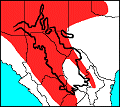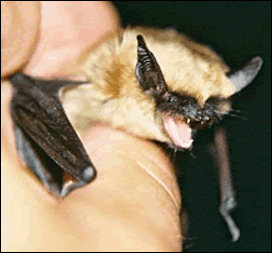


Myotis ciliolabrum. National Park Service photograph.
In the western United States, these bats are typically found near water in chaparral of the Trans-Pecos area and wooded mountainous areas (Tuttle 2003). Daytime roosts may be in cracks and crevices of canyon walls, in caves or mine tunnels, behind tree bark that is loose, or even in abandoned houses (Davis and Schmidly 1994). While hibernation sites have not been discovered in Texas, it is believed that they hibernate in suitable caves or mine tunnels within their summer-time range (Tuttle 2003). In other locations, bats observed in winter are often found wedged deeply into narrow openings in the rock ceilings of old mines, and when they are probed from these crevices, are able to fly, which indicates they do not go into a deep winter hibernation (Davis and Schmidly 1994).
Davis, W. B., and D. J. Schmidly. 1994. The mammals of Texas. Texas Parks and Wildlife Press, Austin.
Tuttle, M. D. 2003. Texas bats. Bat Conservation International, Inc., Austin.
A. Ruth Huckaby, Graduate Student, BIOL 5301—Natural History of the Chihuahuan Desert, June, 2006.
Huckaby Update: 22 June 2006.
Last Update: 23 Jul 2009